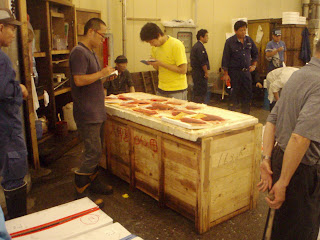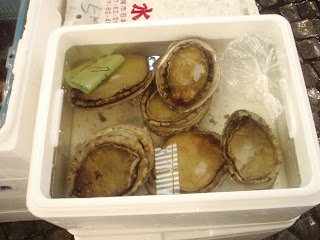

















GETTING BIGGER IN JAPAN: BACK TO THE FISH MARKET AND ON TO HONG KONG
(AGAIN< EXCUSE ME IF THIS IS A TOTAL MISH MASH. I CAN"T READ WHAT I POST IN CHINA, SO DON"T KNOW IF THE IMAGES APPEAR AT ALL OR IN WHAT ORDER)
So, that was it for the tour.
I can’t say enough good things about Intrepid who organised the trip and about Yuka, our young but endlessly enthusiastic tour leader. They maintained the perfect balance of included activities and free time so that I was able to navigate the vagaries of Japan’s culture and language and also find my own story as I travelled around Japan.
One story I had not found was the one that most people had said I must not miss. The Tokyo's Tsukiji Fish market.
As a visitor, be it Japanese or from abroad, the market is a must but, unless you know the places to go and the rules involved, it can be a bit intimidating.
I had arranged to meet up with Aaron Davis, an Australian who has been in Japan for any number of years and who gets to the market as often as he can. It meant a 5am start so that we could be sure to see the auctions in action. A bit of a challenge as I had arrived from Kyoto the day before and, in the evening, made the most of my last opportunity to hit the Yakitori bars of Tokyo.
Apart from fluent Japanese, Aaron counts amongst his skills an amazing capacity to retain facts and, as we walked around, he gave an incredible insight into the market, its history and how it works now.
Originating as a market outside Nihonbashi, the fish market has been in existence for over 350 years from when it was set up to sell off the fish not eaten by the nobility.
In the 1920’s, a huge earthquake hit Tokyo and the market was moved from its original position to the current site in Tsukiji. It may have moved, but the same eight families who were in charge before were still in charge when it moved and are still in charge now. They rank amongst the wealthiest in the country, owning as they do, the fishing fleets, the auction houses and the distribution network of the fish from the market to all parts of Japan
As Aaron explained, the fish bought in the market can be in Osaka or Kyoto by lunchtime and one in every seven people in the country will eat fish that was sold in the market that morning in any given day. It is an incredible feat of logistics and also explains why both the buyers and sellers of fish have to be there from 1am in the morning.
Everyone knows about the incredible tuna that is sold in the market, but, to see it in action was a think of extraordinary marvel. Frozen fish from the Japanese seas are brought in by small shuttle ships that go from trawler to trawler allowing the larger boats to stay at sea constantly. The fish is brought in by one of the eight families and then examined by licensed buyers who tend to buy from the same auctioneer.
They buyers have contracts with numerous clients from high end restaurants, department stores and even convenience store chains to provide fish, so the pressure is really on them to buy the right stuff at the right price.
With tuna going for nearly Y5000 a kilo, it is little wonder that they recently beat the $1,000,000 mark for a single fish.
After we had been to the auction area, Aaron led the way to the Inner Market, which is open only to wholesalers. Unlike most of Japanese society, this is not a place where the men hold sway. Here, the woman is in charge. As the men cut fish, the woman sits in a small wooden cubicle and it is she who does the deals and keeps a track of all the cash.
The array of fish is beyond staggering. Abalone and eel sit along side tuna that would cost more than an arm and a leg back in London if, that is, you could actually get fish of that quality. As well as those fish I recognised, must have been about one hundred types, possibly even more, that I have never set eyes on before and which Aaron said had no English name that he had ever been able to find.
Over 30,000 people work in the market and it is, in effect, its own town within Tokyo which means it also houses a vast network of support services from restaurants to feed the workers to shops selling razor sharp knives and a general market to supply the public.
So, after a long stroll through all the areas of the market, we went for breakfast at Jiro’s. Kujiro’s family have been running a restaurant at the fish market for over 300 years, primarily to the local porters and fish cutters. He spoke decent English, and explained that the mornings assortment of sushi fish had not yet arrived which was a real disappointment but offset by a bowl of rice topped with more of that Unagi of which I had become so fond during my stay. It is not to everybody’s taste as the oiliness of the skin and the fatty nature of the flesh is unusual to say the last, but glazed with the slightly sweet sauce it proved to be the perfect breakfast.
After a quick walk through the back streets around the market including a stop for a squid ink ice cream, it was time to head back to the hotel and check out.
I pottered around Ueno for an hour or so before heading out to the airport and off to Hong Kong.
So, that was Japan, a little over two weeks in which I got the impression, I saw a lot and saw almost nothing this country has to offer. In which I tasted amazing things but tasted only a fraction of the extraordinary variety of what is to be found. In which I met the most friendly people but did not even begin to get below the skin of what make the Japanese people tick. In which, just when I thought I had the culture and the country sussed, something else popped up to throw me for a loop and make me realise that I understood the country not at all.
I ate incredibly well, from the simplest skewers of bits in the Yakitori bars of Piss Alley to the formal setting of our Kaiseki meal in Takyama. But, most of all, as EAT MY GLOBE was meant to be, the food brought me in touch with people. Not just people like Koji in Tokyo who treated me to my first meal in Japan, Tokomo in Kyoto who stood patiently by as I made a pig’s ear of my attempts at Maki Sushi or Yuka who stood equally patiently by as I stumbled off a bullet train with all the grace of a drunken elephant. But, also, Drew, the game, untravelled Australian who became my Sancho Panza in a quixotic search for good things to eat, John, the New Zealander whose beer glass never seemed to empty and who made sure that no one else’s did either and Devesh and Surat, who managed to persuade the Japanese that Vegetarianism was not akin to child molestation.
When I set out on this trip, I thought that it would bring me in contact with lots of local people from each region I visit. It has certainly done that. But, it has also brought me in touch with other visitors whose reasons for visiting places are different from but equally as valid as my own. They are proving to be just as much, if not more, a part of the story than I had ever anticipated.
Japan certainly did not let me down.
Let’s see what Hong Kong has to offer

3 comments:
I must say this is one of the food visits i want to make soon. Perhaps I'll make it at Christmas. Looks amazing. Did you bring any knives home?
A great trip indeed.
Enjoyed every minute of your company too mate.
Waiting for the book:-)
Hey Simon....Let us know when you want us back in Japan for the EAT MY GLOBE TV series....The food sure was good in Takayama but I won't forget the view !!!!! Those robes were definately made for japanese sizes......Ha Ha....enjoy the trans Siberian.....
Post a Comment